According to the Australian Bureau of Statistics, a person is considered homeless if their current living arrangement, is in a dwelling that is inadequate or has no tenure, or if their initial tenure is short and not extendable ordoes not allow them to have control of, and access to space for social relations.
Introduction
According to the Australian Bureau of Statistics, a person is considered homeless if their current living arrangement:
- is in a dwelling that is inadequate; or
- has no tenure, or if their initial tenure is short and not extendable; or
- does not allow them to have control of, and access to space for social relations.
According to the 2011 Census, most commonly homeless people live in severely overcrowded houses or access supported accommodation. They may also stay in improvised dwellings, tents or ‘sleep rough’.
A number of national studies inform our view of the causes of homelessness. Specialist homelessness services report, for example, the main reasons people give for accessing services as: family violence (25%), financial difficulties (15%), housing crisis/affordability (18%), inadequate or inappropriate dwellings (10%) and relationship or family breakdown (6%). However, a person’s experience of homelessness is often the result of a complex interaction between a number of social, economic and demographic factors.
Homelessness research consistently shows biased and inaccurate perceptions and attitudes towards homelessness. Studies often identify an incorrect view held by many Australians that the main drivers of homelessness are personal, such as drug and alcohol problems, and the most common demographic group experiencing homelessness is young males. In a recent survey conducted by Homelessness Australia, 64 per cent of respondents thought the main way a person could ‘get out of homelessness’ was to ‘get a job’. This response fails to recognise the multiple barriers (health and mental health issues, experience of family violence, lack of education, poverty, intergenerational disadvantage or substance abuse) many people face in exiting homelessness.
Relationships Australia’s July online survey tested our website visitors’ perceptions of homelessness.
Previous research finds that…
- In 2011 there were more than 105,000 homeless people on Census night; 60% of homeless people were aged less than 35 years.
- While more males were homeless on Census night, 59% of people supported by specialist homelessness services are female.
- The most common reasons for homelessness are family violence and money problems/housing affordability.
- Children under the age of 18 make up 27% of people experiencing homelessness.
Survey Results Analysis
More than 1970 people responded to the Relationships Australia online survey in July. Almost four-fifths of survey respondents (81%) identified as female.
As was the case for last month’s survey, more females than males responded in every age group (Figure 1). More than eighty-five per cent of survey respondents were aged between 20‑59 years, with the highest number of responses collected for women aged between 30-39 years (inclusive).
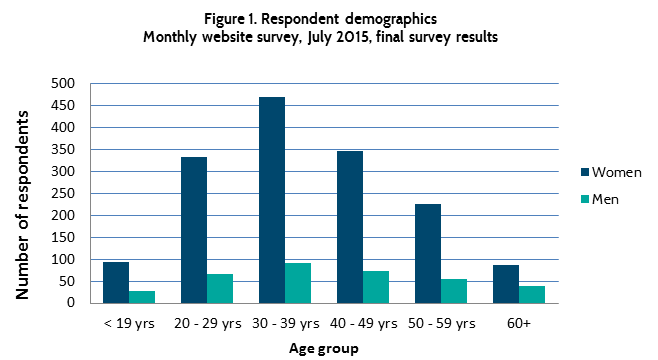
The demographic profile of survey respondents remains consistent with our experience of the groups of people that would be accessing the Relationships Australia website.
Survey participants were asked who they thought were the most likely group to be homeless (figure 2).
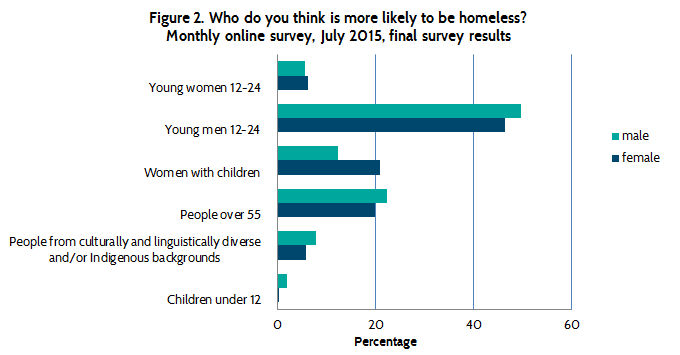
Both male and female survey respondents overestimated the number of young men and underestimated the number of women experiencing homelessness; however, men were significantly more likely to underestimate the number of women experiencing homelessness. Half of men and women considered that young men were the most likely people to be homeless, while one‑fifth of women reported that they thought women with children or people aged over 55 years were the most likely to be homeless. One-fifth of men also reported people aged over 55 years were the most likely to be homeless, but only one-tenth (12%) considered women with children were the most likely people to be homeless.
When compared to actual rates, figure 3 shows that both female and male survey respondents were also likely to overstate the number of people sleeping in tents, cars or makeshift shelters (45% compare with an actual rate of 6%), and underestimate the number of homeless people sleeping in houses with other people (18% compared with an actual rate of 56%) and homelessness shelters (7% compared with an actual rate of 20%).
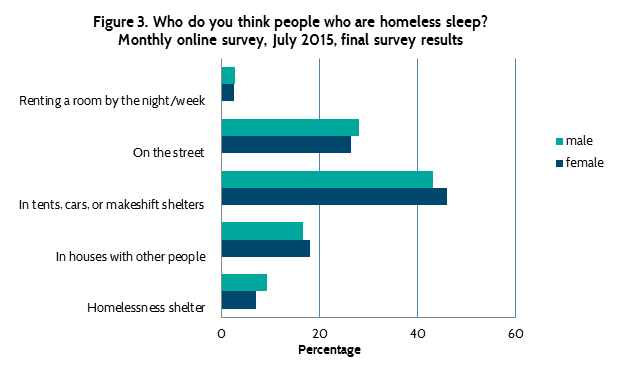
Figure 4 reports on perceptions of the reasons for homelessness. Almost half of survey respondents reported that they though mental health or drug/alcohol issues were the reasons for people experiencing homelessness. Women (30%) were more likely than men (24%) to report family violence as a reason for homelessness, while men (19%) were more likely than women (15%) to report money problems as a reason for homelessness, all underreports of actual reasons for homelessness.
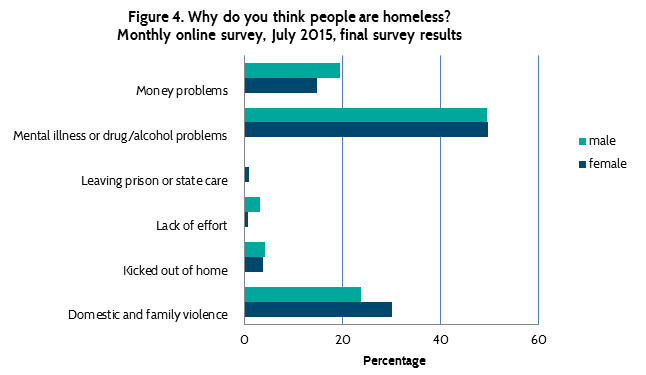
Survey respondents were most likely to report that they thought governments (55%) or the local community (32%) were responsible for solving homeless (figure 5). Similar to the results of previous surveys on the public perceptions of homelessness, visitors to our website appeared to recognise that government and community responses are needed to solve large social issues such as homelessness.
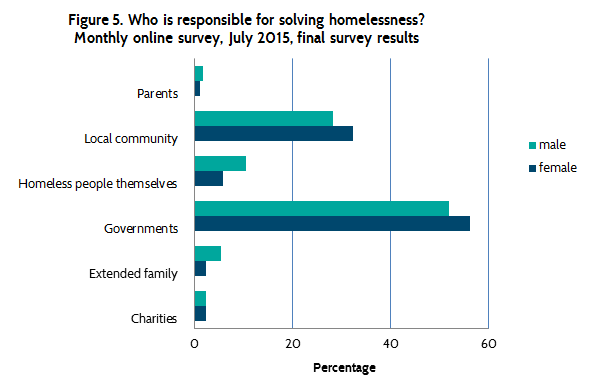
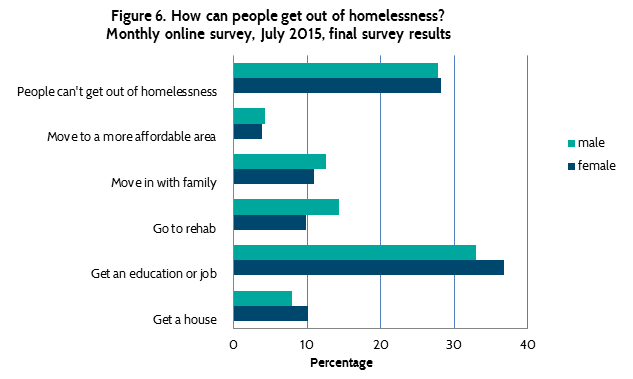
Similar to the findings of Homelessness Australia’s survey, a high proportion of survey respondents (36%) thought that getting an education or job was a pathway out of homelessness (figure 6). In contrast, more than one‑quarter (28%) of respondents reported that they thought people can’t get out of homelessness, suggesting these respondents recognise the complex situations of people experiencing homelessness.
References
Australian Bureau of Statistics (2012). Census of Population and Housing: Estimating homelessness. available at http://www.abs.gov.au/AUSSTATS/abs@.nsf/Latestproducts/2049.0Main%20Features22011?opendocument&tabname=Summary&prodno=2049.0&issue=2011&num=&view=
Homelessness Australia (2015). Perceptions of homelessness. Available at http://homelessnessaustralia.org.au
www.abs.gov.au/ausstats/abs@.nsf/latestProducts/2049.0Media%20Release12011
www.homelessnessaustralia.org.au/images/publications/Fact_Sheets
Acknowledgement
Relationships Australia would like to acknowledge the assistance of Homelessness Australia in developing the questions for July’s monthly survey.